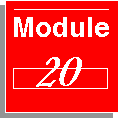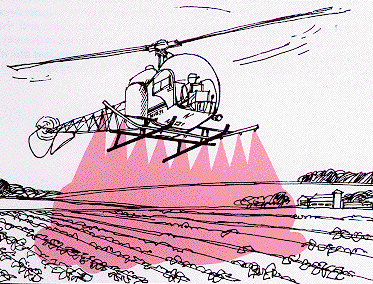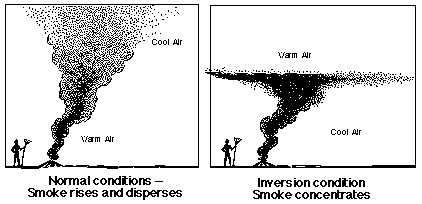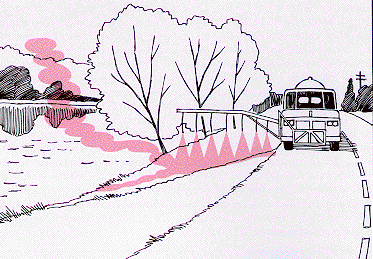Weather-Wise Application

Weather-Wise Application
Weather-wise application can reduce pesticide hazard to the environment.
A good applicator carefully checks the weather conditions before beginning spray
procedures. Not only do a few simple precautions protect the environment, but in
terms of dollars and cents they aid the applicator. Pesticides which do not
reach or remain on the target areas are wasted. More pesticide, time, and money
must be used to control the pests in the target area.

Goals of This Chapter
- Learn the role that weather conditions can play in both helping and hindering
the applicator.
- Understand the hazards of windy day application and who is legally responsible
for mistakes.
- Learn the advantages of early morning or evening application.
- Understand the roles of humidity and temperature inversion in regard to
pesticide application.
Avoid High Temperature and Low Humidity Conditions
Temperature and humidity affect pesticide drift. High temperature and low
humidity increase the rate of evaporation of the pesticide. Small droplets that
completely evaporate leave pesticide particles in the air that may be carried
several miles away from the treatment area (vapor drift).
Avoid Windy Days
High winds increase drift and result in the loss of pesticide from treated
areas. Drifting pesticides increase the possibility of injury to wildlife,
pollinators, and domestic animals. They may settle on forage, pasture or
wildlife areas or contaminate water. Pesticide application on quiet days reduces
the inhalation and contact hazard to the applicator and the bystander. Drift
onto sensitive crop areas can also be avoided in this way. The applicator is
legally responsible for any injury or money loss due to pesticide drift onto
non-target areas. Don't take a chance by spraying in the wind.
 Would you like to try a study question?
Would you like to try a study question?
 Would you like to try a study question?
Would you like to try a study question?
 Would you like to try a study question?
Would you like to try a study question?
 Would you like to try a study question?
Would you like to try a study question?
 Would you like to try a study question?
Would you like to try a study question?
Other Wind and Temperature Considerations
The drift of pesticides is also affected by the air turbulence. The air
turbulence is determined by the difference between the temperature at ground
level and the temperature of the air above it. Normal weather conditions cause
heating of the soil. If the air just above the soil is warmer than the air
aloft, upward air currents begin. The larger the temperature difference between
air above the soil surface and the air aloft, the stronger the air currents.
These air currents could carry spray droplets and pesticide particles a
considerable distance away from the treatment area. Do not apply pesticides when
such turbulent conditions exist.
An inversion occurs when the air near the soil surface is cooler than the air
above it. The warm air forms a cap that blocks upward air movement that would
otherwise help disperse the chemicals. Wind can aid in air mixing and reduce
inversion conditions. However, low wind conditions during inversion conditions
may cause small spray drops to remain suspended in the air. The droplets will
eventually move out of the treatment area as a concentrated cloud. Smoke can be
used as a good indicator of an inversion condition. Do not apply pesticides when
inversion conditions exist.
 Would you like to try a study question?
Would you like to try a study question?
 Would you like to try a study question?
Would you like to try a study question?
 Would you like to try a study question?
Would you like to try a study question?

Avoid Application Just Before Rains
Spray applications should not be made just before a rain, because the pesticide
washes off and the pests are not controlled. Rains cause runoff and tend to wash
the pesticide away from the target areas. The runoff can carry the pesticide
into sensitive areas where crops or wildlife could be injured. Runoff can also
reach surface waters such as farm ponds, streams and waterways. Ultimately, this
can cause contamination, fish kills, and injury to domestic animals.
 Would you like to try a study question?
Would you like to try a study question?
 Would you like to try a study question?
Would you like to try a study question?

Consider Early Morning or Evening Application
Wind speed is usually lowest and humidity higher at these times of the day, thus
drift hazard is greatly reduced. Children and domestic animals are less likely
to be in sprayed areas during these hours. Avoiding full daylight hours lowers
the contact danger to wildlife such as birds, mammals, and pollinators, who
often visit crop lands during the day.
 Would you like to try a study question?
Would you like to try a study question?
Back to Top